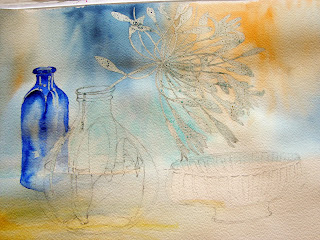At Avon Valley Art Group this week, the subject was 'Glass'. I thought about what I could attempt, knowing that the 'glass' part of the painting would be quite demanding, but wanting to make as good a finished painting as possible.
I borrowed a couple of glass bottles from a friend and looked out a glass bowl from among my many props and decided to add a large flower head to the painting. I think, sub-consciously, I hoped this might detract from any deficiencies in the painting of the glass.
I have been very busy this week doing painting of a different kind in our lounge, but I made sure that I found the time to do as reasonable a drawing as possible.
I wanted to be able to add the background wash reasonably easily, so I blocked out the Agapanthus flowers with Pebeo Drawing Gum, using a 'Shaper Maker' instead of a brush. This was quicker and gave more even shapes. I also used the gum to retain the highlights on the glass, although I knew that when I got to the group the following morning, the light would be completely different.
I was also anxious to complete enough of the painting, to enable me to remove the gum asap as I did not want it to spoil the surface of the paper.
I painted in the background wash, making sure that there were shades of blue behind the LH bottle, which I then added, making sure that some of the colour was visible behind the central shape.
Next, it was time to add the stem and leaves inside the bottle in the foreground, and when they were dry, I painted in the pale glass, and tried to give an impression of water. I had spent some time in the studio, the previous evening, working out what these elements would look like, by placing a random twig with leaves from the garden, in a jar of water!( I was painting the flowers from memory)
I also began to add detail to the RH bowl. I then began to remove the gum a little at a time, to paint in the flowers. I did this gradually, as in removing the gum, the pencil drawing is also removed. I wanted to try to remember which flowers and stems were forwards or backwards in the composition, and by doing it a bit at a time, I was able to do this.
I finally added a bit more strength to the background, trying to get it to show through the glass without darkening it too much. The final painting seems a bit lacking in my usual contrasts of light and dark, but its ok.
At our 'end-of-session' viewing of the group's work we all agreed that painting glass objects successfully, is a difficult task, as there are so many elements to bring together, but members seem to enjoy being set a challenge, so I am sure it will appear on the programme again.


















































